Strength Analysis of Eight-Wheel Bogie of Bucket Wheel Excavator
Abstract
:1. Introduction
2. Calculation of Loads
2.1. Mean Vertical Wheel Load
2.2. Loads on the Supporting Structure from the Tension of the Crawler’s Chain
3. FEM Model of Eight-Wheel Bogie
4. Results and Discussion
5. Conclusions
Author Contributions
Funding
Data Availability Statement
Conflicts of Interest
References
- Thermal Power Plants. Available online: https://www.eps.rs/eng/Poslovanje-EE/Pages/Termoelektrane.aspx (accessed on 10 November 2022).
- Bagger 293: Největší a Nejtěžší Vozidlo na Světě. Available online: https://www.stoplusjednicka.cz/bagger-293-nejvetsi-nejtezsi-vozidlo-na-svete (accessed on 27 January 2013).
- Savkovic, S.; Jovancic, P.; Djenadic, S.; Tanasijevic, M.; Miletic, F. Development of the hybrid MCDM model for evaluating and selecting bucket wheel excavators for the modernization process. Expert Syst. Appl. 2022, 201, 117199. [Google Scholar] [CrossRef]
- Moczko, P.; Pietrusiak, D.; Rusiński, E. Material handling and mining Equipment: International standards recommendations for design and testing. FME Trans. 2018, 46, 291–298. [Google Scholar] [CrossRef]
- Bošnjak, S.; Gnjatović, N. Bucket Wheel Excavators: Balancing and Dynamic Response of the Slewing Superstructure. In Proceedings of the 5th International Mechanical Engineering in XXI Century, Nis, Serbia, 9–10 December 2020. [Google Scholar]
- Bošnjak, S.; Pantelić, M.; Zrnić, N.; Gnjatović, N.; Đorđević, M. Failure analysis and reconstruction design of the slewing platform mantle of the bucket wheel excavator O&K SchRs 630. Eng. Fail. Anal. 2011, 18, 658–669. [Google Scholar] [CrossRef]
- Marinković, A.; Lazović, T.; Grbović, A.; Stanković, M.; Minewitsch, A. Contact stress study and FME analysis of large size thrust ball bearings. In Proceedings of the 5th International Conference on Power Transmissions BAPT2016, Ohrid, Republic of North Macedonia, 5–8 October 2016; pp. 7–14. [Google Scholar]
- Bošnjak, S.; Zrnić, N.; Simonović, A.; Momčilović, D. Failure analysis of the end eye connection of the bucket wheel excavator portal tie-rod support. Eng. Fail. Anal. 2009, 16, 740–750. [Google Scholar] [CrossRef]
- Bošnjak, S.M.; Arsić, M.A.; Zrnić, N.Đ.; Rakin, M.P.; Pantelić, M.P. Bucket wheel excavator: Integrity assessment of the bucket wheel boom tie-rod welded joint. Eng. Fail. Anal. 2011, 18, 212–222. [Google Scholar] [CrossRef]
- Danicic, D.; Sedmak, S.; Ignjatovic, D.; Mitrovic, S. Bucket Wheel Excavator Damage by Fatigue Fracture—Case Study. Procedia Mater. Sci. 2014, 3, 1723–1728. [Google Scholar] [CrossRef] [Green Version]
- Arsić, D.; Gnjatović, N.; Sedmak, S.; Arsić, A.; Uhričik, M. Integrity assessment and determination of residual fatigue life of vital parts of bucket-wheel excavator operating under dynamic loads. Eng. Fail. Anal. 2019, 105, 182–195. [Google Scholar] [CrossRef]
- Arsić, M.; Bošnjak, S.; Gnjatović, N.; Sedmak, S.; Arsić, D.; Savić, Z. Determination of Residual Fatigue Life of Welded Structures at Bucket-Wheel Excavators through the Use of Fracture Mechanics. Procedia Struct. Integr. 2018, 13, 79–84. [Google Scholar] [CrossRef]
- Savković, M.; Gašić, M.; Arsić, M.; Petrović, R. Analysis of the axle fracture of the bucket wheel excavator. Eng. Fail. Anal. 2011, 18, 433–441. [Google Scholar] [CrossRef]
- Bošnjak, S.M.; Savićević, S.D.; Gnjatović, N.B.; Milenović, I.L.; Pantelić, M.P. Disaster of the bucket wheel excavator caused by extreme environmental impact: Consequences, rescue and reconstruction. Eng. Fail. Anal. 2015, 56, 360–374. [Google Scholar] [CrossRef]
- Bošnjak, S.M.; Petković, Z.D.; Simonović, A.M.; Zrnić, N.; Gnjatović, N.B. ‘Designing-in’ failures and redesign of bucket wheel excavator undercarriage. Eng. Fail. Anal. 2013, 35, 95–103. [Google Scholar] [CrossRef]
- Fragassa, C.; Berardi, L.; Balsamini, G. Magnetorheological fluid devices: An advanced solution for an active control on the wood manufacturing process. FME Trans. 2016, 44, 333–339. [Google Scholar] [CrossRef] [Green Version]
- Beno, P.; Krilek, J.; Kovac, J.; Kozak, D.; Fragassa, C. The analysis of the new conception transportation cableway system based on the tractor equipment. FME Trans. 2018, 46, 17–22. [Google Scholar] [CrossRef] [Green Version]
- Martini, A.; Bellani, G.; Fragassa, C. Numerical Assessment of a New Hydro-Pneumatic Suspension System for Motorcycles. Int. J. Automot. Mech. Eng. 2018, 15, 5308–5325. [Google Scholar] [CrossRef]
- Pavlovic, A.; Fragassa, C.; Minak, G. Buckling analysis of telescopic boom: Theoretical and numerical verification of sliding pads. Teh. Vjesn. 2017, 24, 729–735. [Google Scholar] [CrossRef] [Green Version]
- Fragassa, C.; Minak, G.; Pavlovic, A. MEASURING DEFORMATIONS IN THE TELESCOPIC BOOM UNDER STATIC AND DYNAMIC LOAD CONDITIONS. Facta Univ. Ser. Mech. Eng. 2020, 18, 315–328. [Google Scholar] [CrossRef]
- Savković, M.; Gašić, M.; Petrović, D.; Zdravković, N.; Pljakić, R. Analysis of the drive shaft fracture of the bucket wheel excavator. Eng. Fail. Anal. 2012, 20, 105–117. [Google Scholar] [CrossRef]
- Rusiński, E.; Czmochowski, J.; Moczko, P. Half-shaft undercarriage systems—Designing and operating problems. J. Achiev. Mater. Manuf. Eng. 2009, 33, 62–69. [Google Scholar]
- Bošnjak, S.M.; Momčilović, D.B.; Petković, Z.D.; Pantelić, M.P.; Gnjatović, N.B. Failure investigation of the bucket wheel excavator crawler chain link. Eng. Fail. Anal. 2013, 35, 462–469. [Google Scholar] [CrossRef]
- Maślak, P.; Smolnicki, T.; Pietrusiak, D. Strain gauges measurements and fem analysis of elements of chassis of open cast mining machines. Tech. Gaz. 2013, 20, 655–658. [Google Scholar]
- Bošnjak, S.; Petković, Z.; Zrnic, N.; Pantelić, M.; Obradovic, A. Failure analysis and redesign of the bucket wheel excavator two-wheel bogie. Eng. Fail. Anal. 2010, 17, 473–485. [Google Scholar] [CrossRef]
- Bošnjak, S.; Petković, Z.; Gnjatović, N.; Milenović, I.; Jerman, B. Impact of the track wheel axles on the strength of the bucket wheel excavator two-wheel bogie. Teh. Vjesn. 2013, 20, 803–810. [Google Scholar]
- Bošnjak, S.; Petković, Z.; Gnjatović, N.; Milenović, I.; Milojević, G. Strength analysis of bucket wheel excavator’s eight-wheel equalizing system. In Proceedings of the 13th International Conference Research and Development in Mechanical Industry RaDMI 2013, Kopaonik, Serbia, 12–15 September 2013. [Google Scholar]
- Kojić, M.; Slavković, R.; Živković, M.; Grujović, N. Finite Element Method 1—Linear Analysis, 2nd ed.; University of Kragujevac, Mechanical Faculty: Kragujevac, Serbia, 2010. (In Serbian) [Google Scholar]
- Bathe, K. Finite Element Procedures; Prentice Hall: Hoboken, NJ, USA; Pearson Education, Inc.: New York, NY, USA, 2006. [Google Scholar]
- DIN 22261-2; Excavators, Spreaders and Auxiliary Equipment in Opencast Lignite Mines—Part 2: Calculation Principles. Deutsches Institut für Normung: Berlin, Germany, 2016.
- Durst, W.; Vogt, W. Bucket Wheel Excavator; Trans Tech Publications: Clausthal-Zellerfeld, Germany, 1989. [Google Scholar]
- FEMAP. User Guide Version 11.2; Siemens Product Lifecycle Management Software Inc.: Plano, TX, USA, 2016. [Google Scholar]
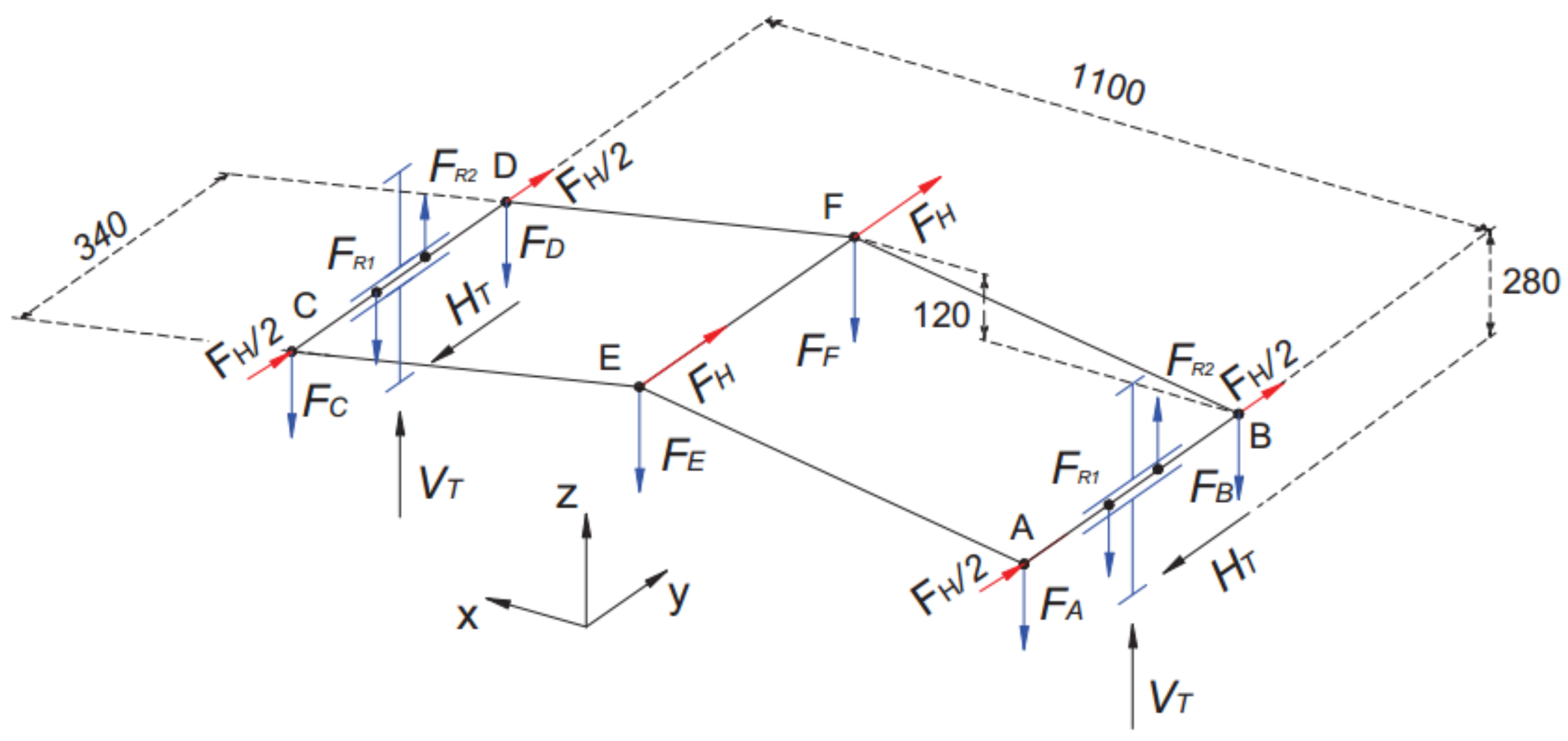


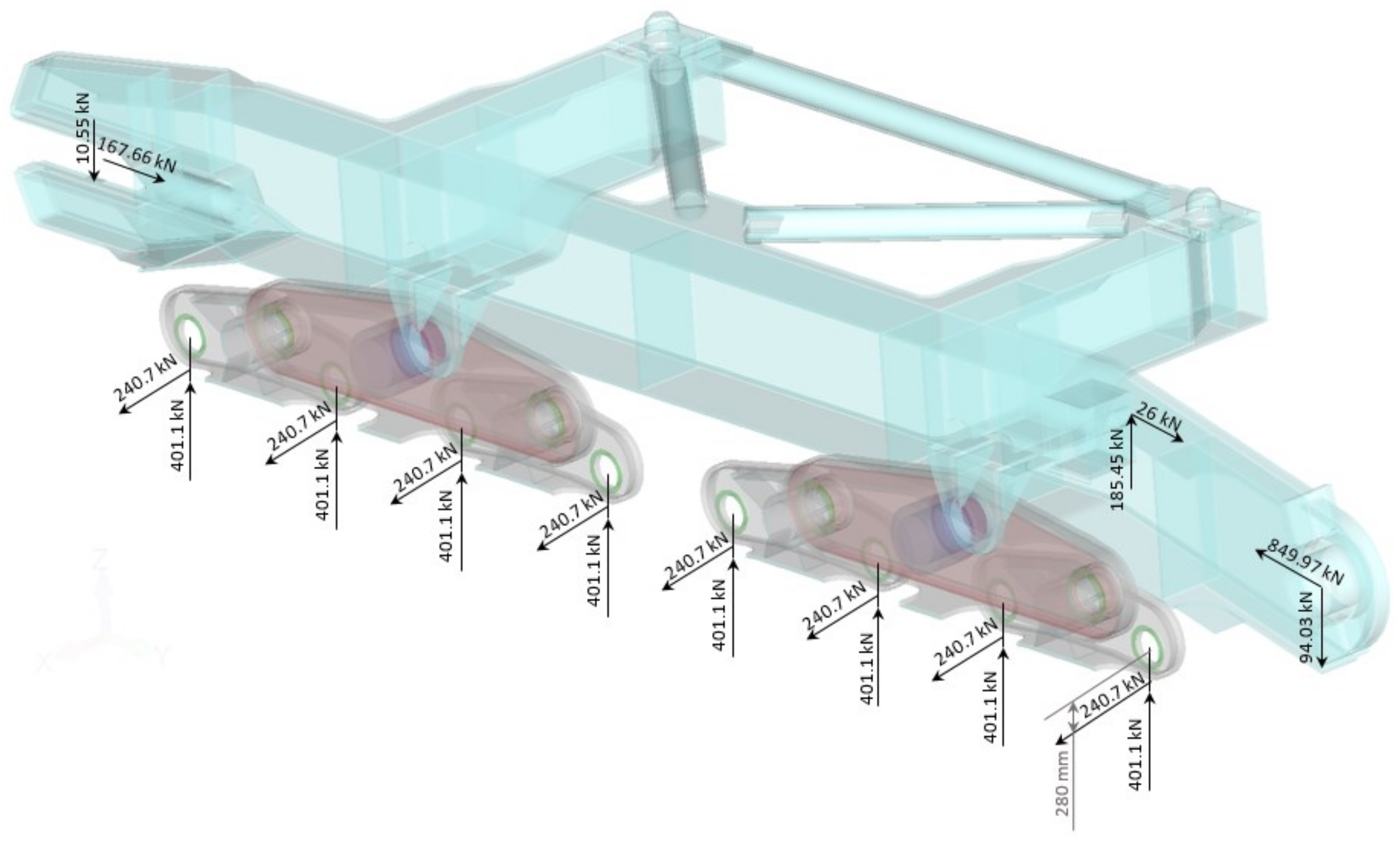


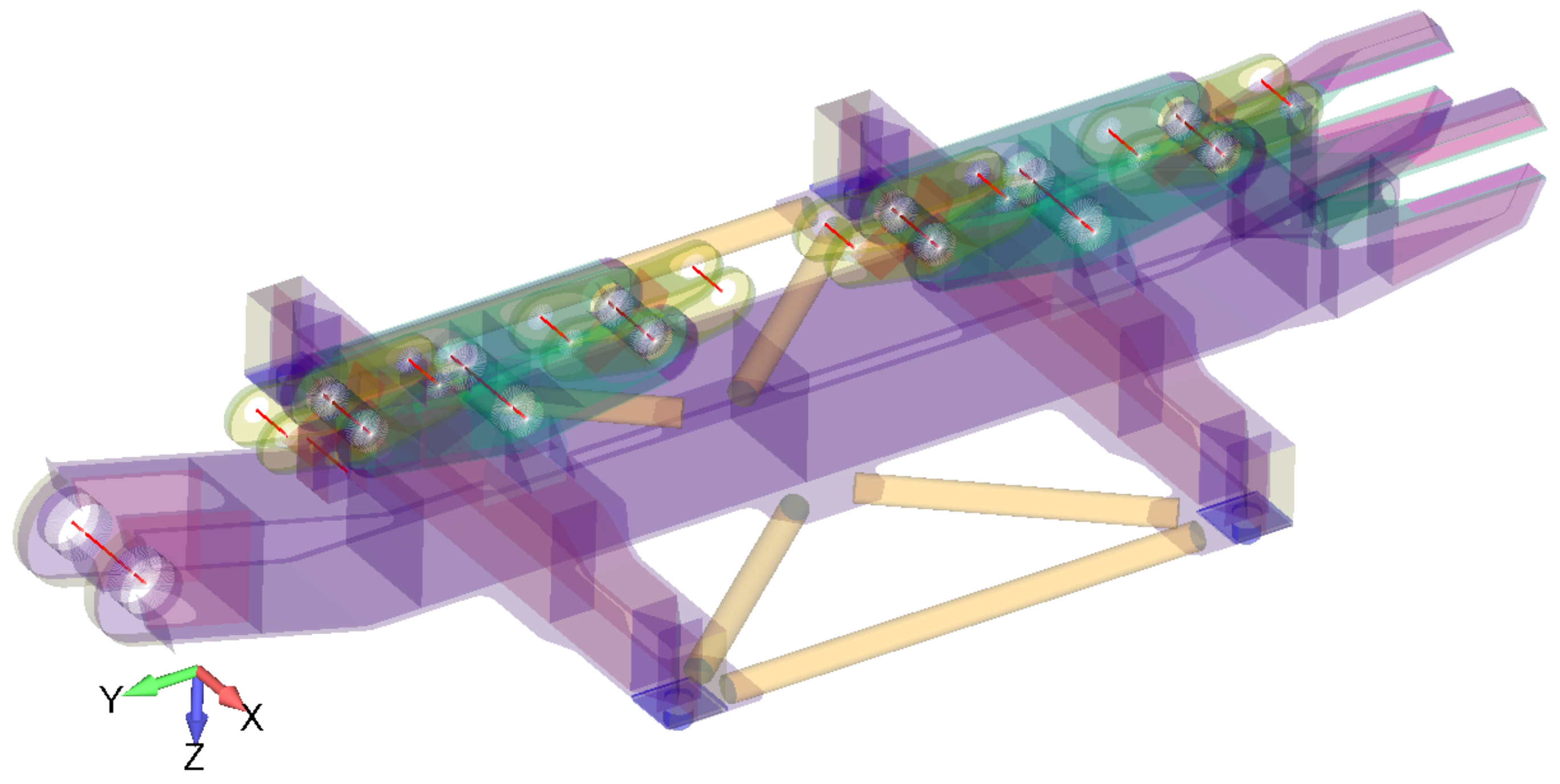

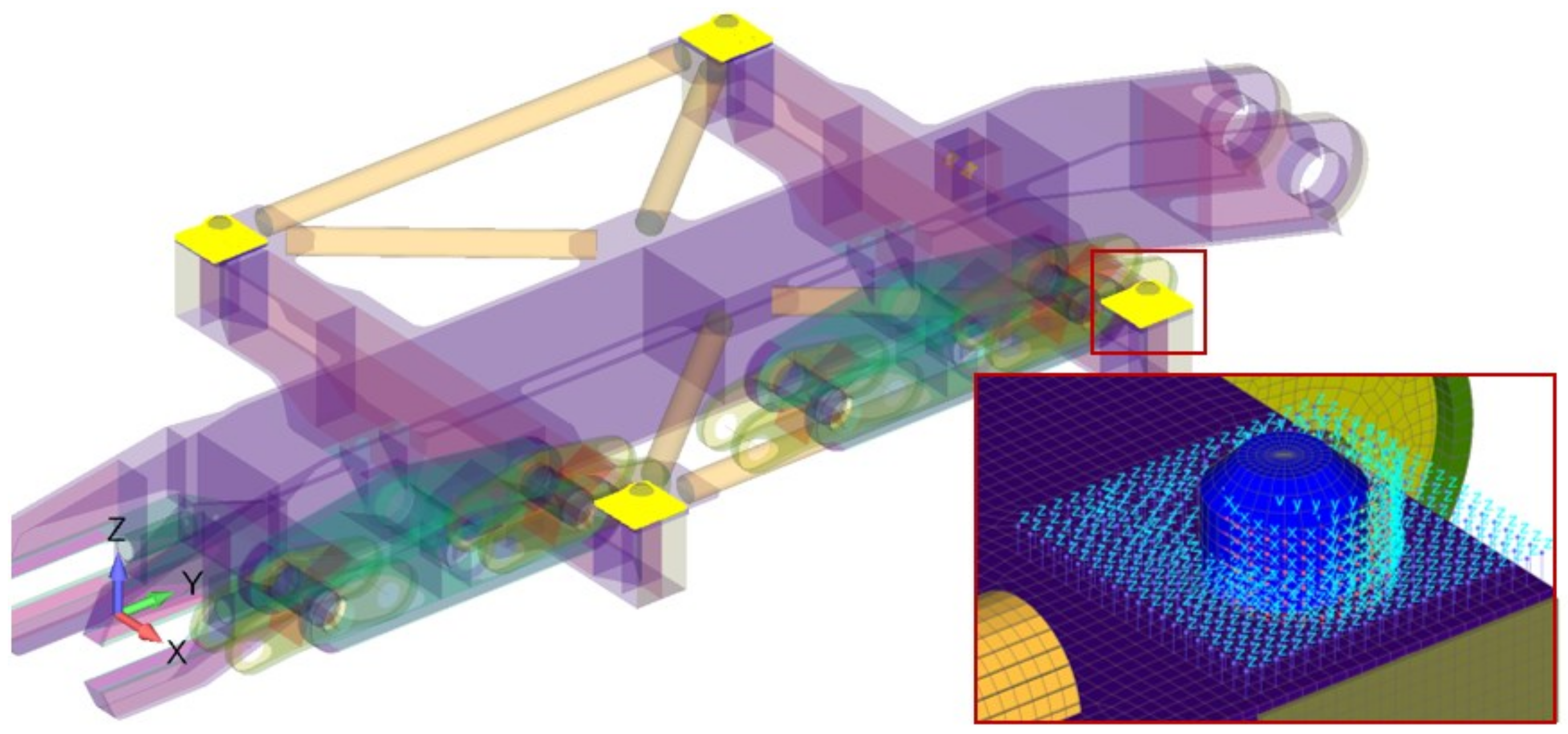
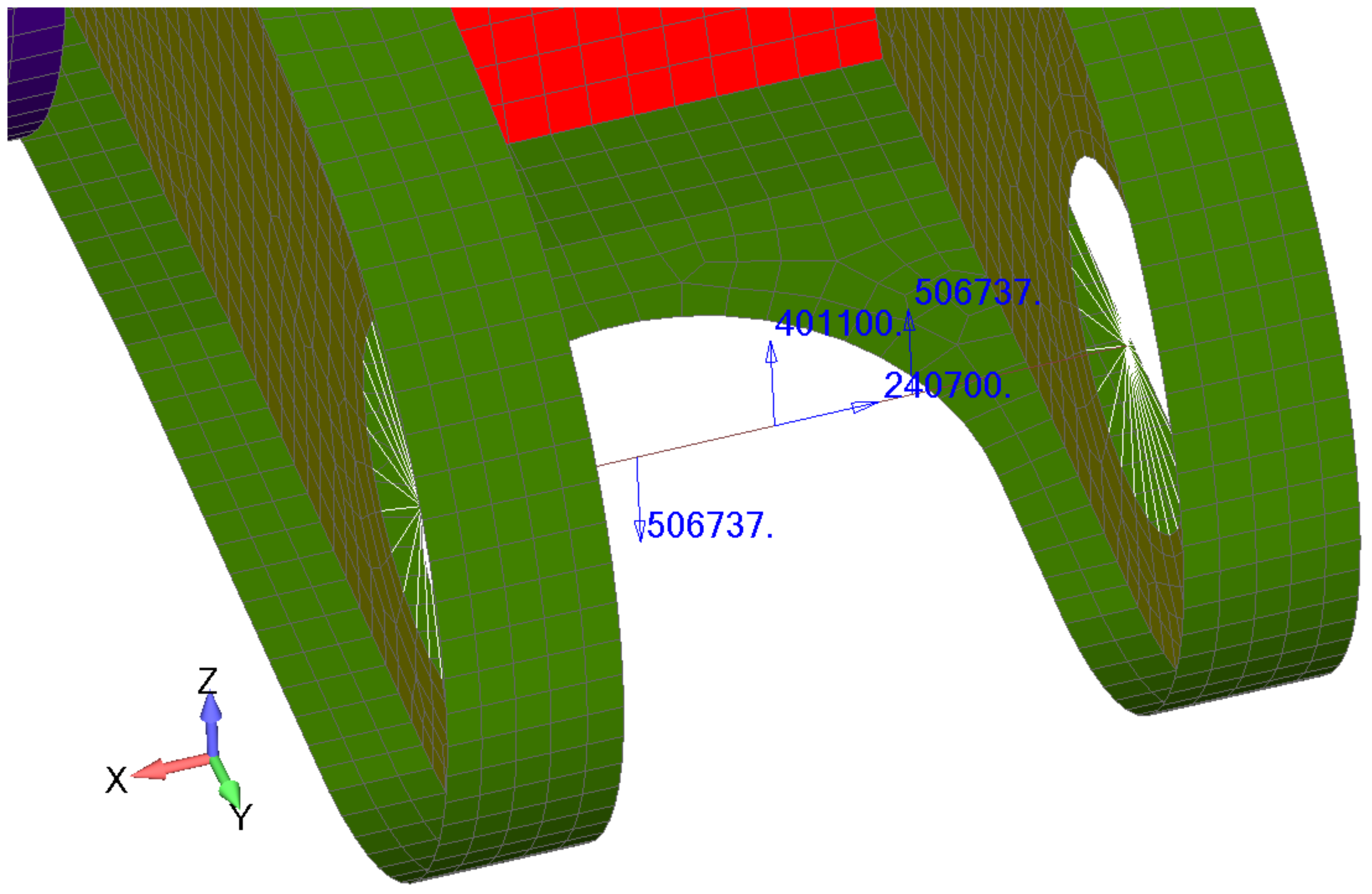


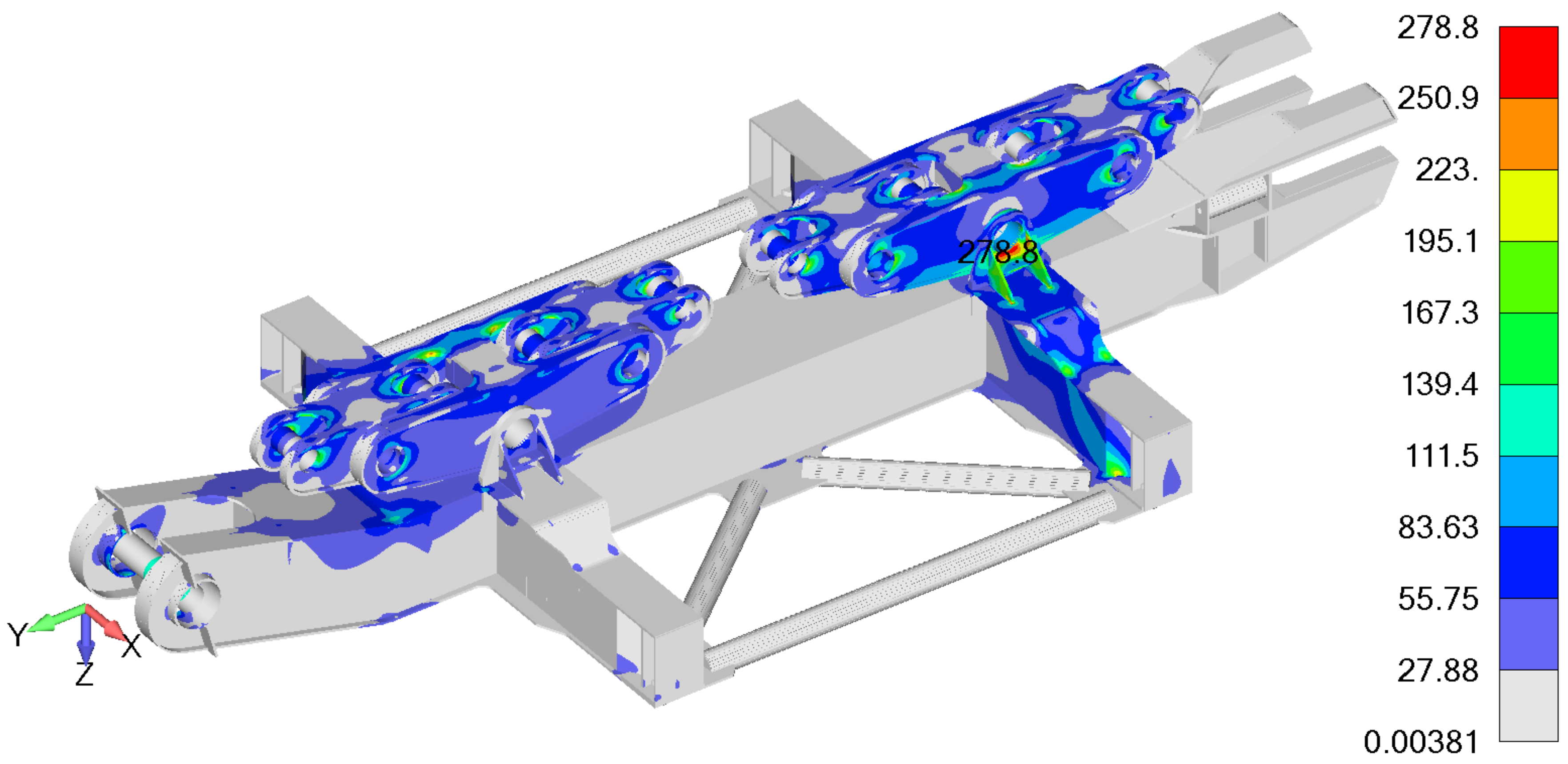
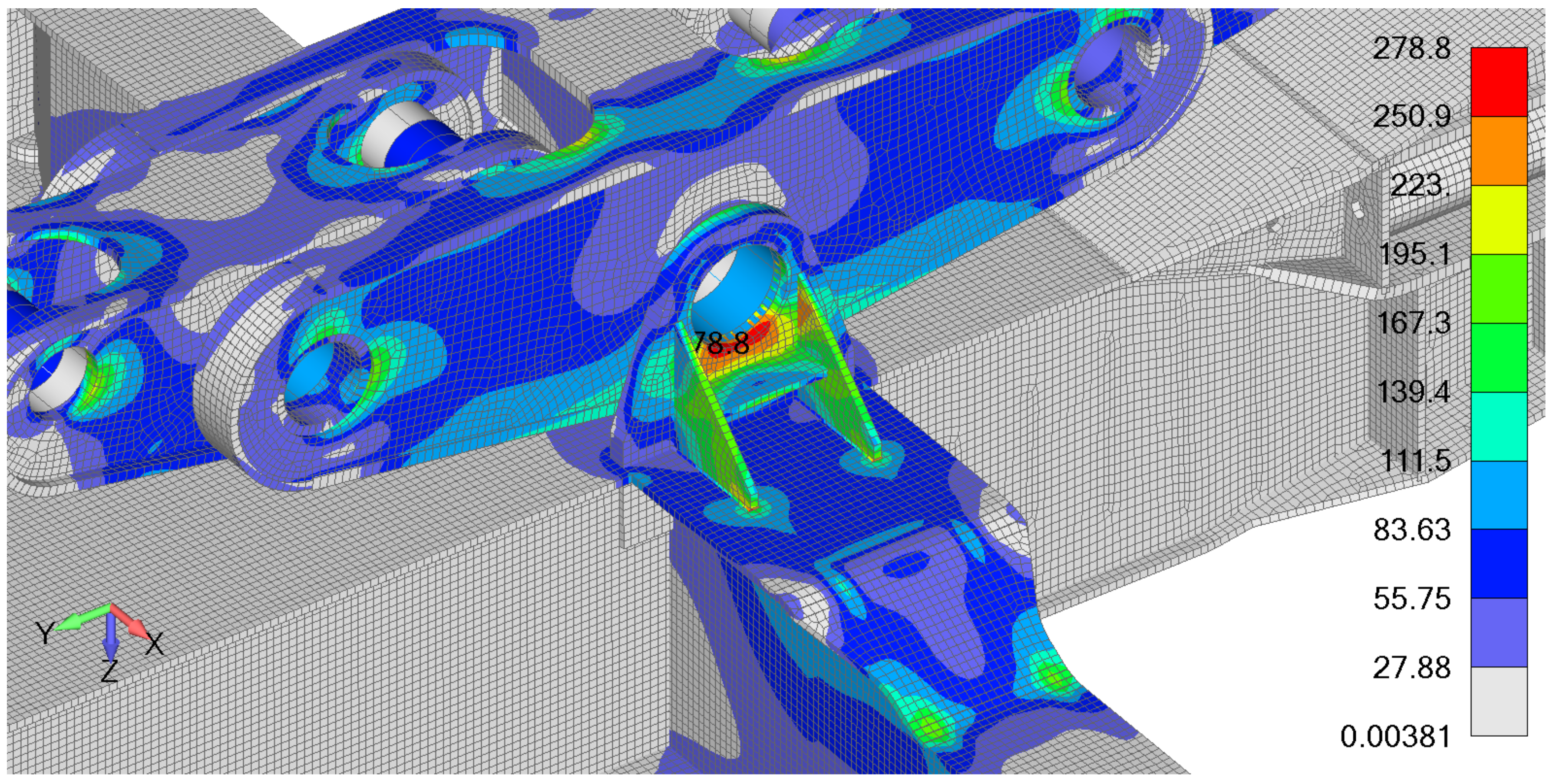
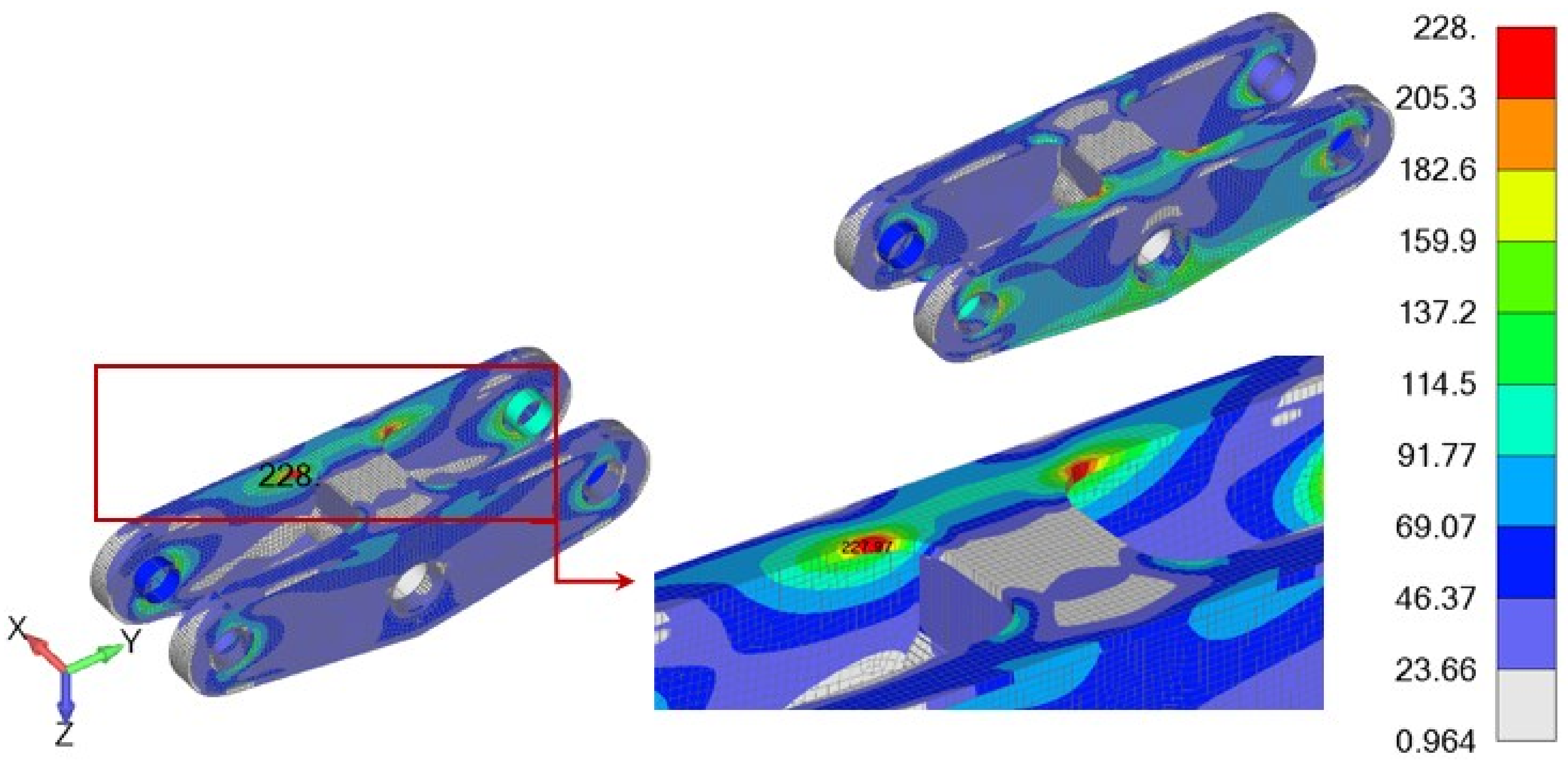
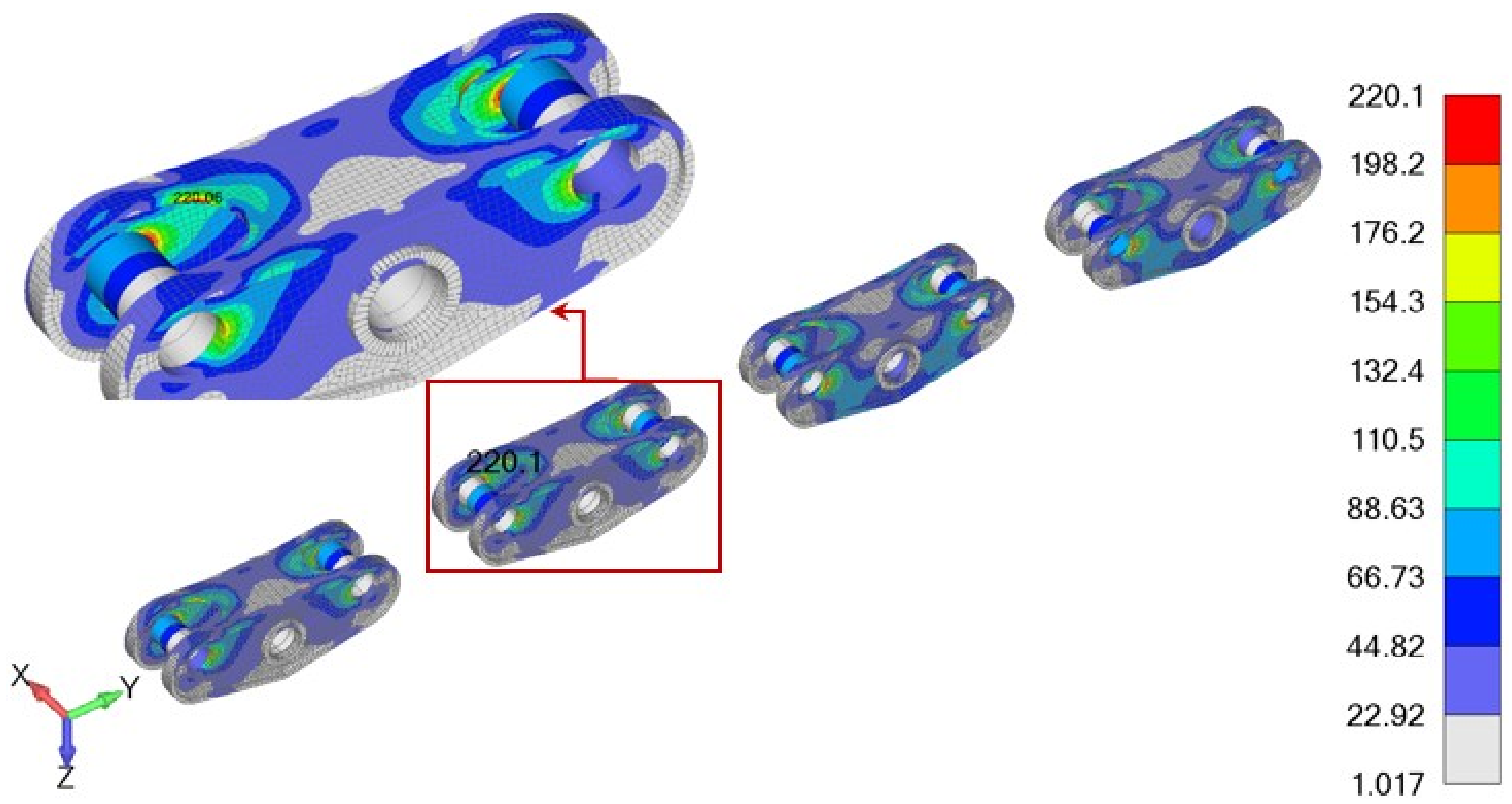
| Material | Modulus of Elasticity/MPa | Poisson’s Ratio | Density/kg·m−3 |
|---|---|---|---|
| S355J2 + N | 2.1 × 105 | 0.3 | 7850 |
| Thickness/mm | ||
|---|---|---|
| d ≤ 16 | 355 | 322.7 |
| 16 < d ≤ 40 | 345 | 313.6 |
| 40 < d ≤ 63 | 335 | 304.5 |
Disclaimer/Publisher’s Note: The statements, opinions and data contained in all publications are solely those of the individual author(s) and contributor(s) and not of MDPI and/or the editor(s). MDPI and/or the editor(s) disclaim responsibility for any injury to people or property resulting from any ideas, methods, instructions or products referred to in the content. |
© 2023 by the authors. Licensee MDPI, Basel, Switzerland. This article is an open access article distributed under the terms and conditions of the Creative Commons Attribution (CC BY) license (https://creativecommons.org/licenses/by/4.0/).
Share and Cite
Vulovic, S.; Zivkovic, M.; Pavlovic, A.; Vujanac, R.; Topalovic, M. Strength Analysis of Eight-Wheel Bogie of Bucket Wheel Excavator. Metals 2023, 13, 466. https://doi.org/10.3390/met13030466
Vulovic S, Zivkovic M, Pavlovic A, Vujanac R, Topalovic M. Strength Analysis of Eight-Wheel Bogie of Bucket Wheel Excavator. Metals. 2023; 13(3):466. https://doi.org/10.3390/met13030466
Chicago/Turabian StyleVulovic, Snezana, Miroslav Zivkovic, Ana Pavlovic, Rodoljub Vujanac, and Marko Topalovic. 2023. "Strength Analysis of Eight-Wheel Bogie of Bucket Wheel Excavator" Metals 13, no. 3: 466. https://doi.org/10.3390/met13030466





